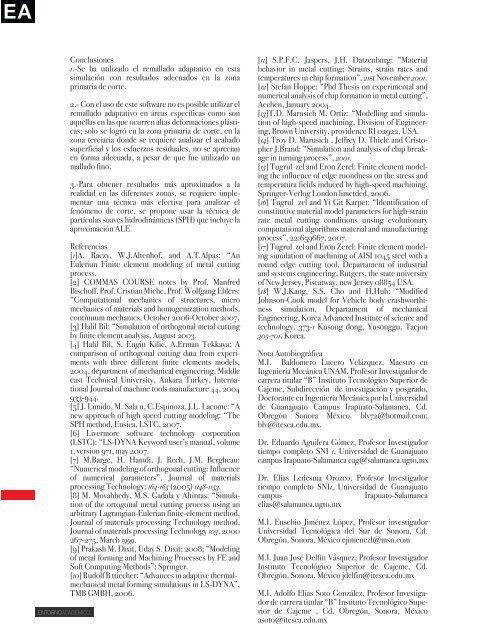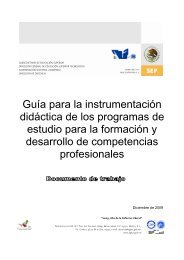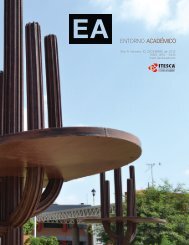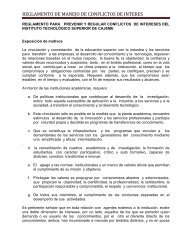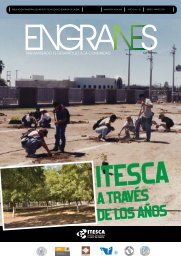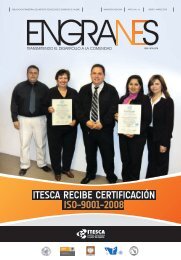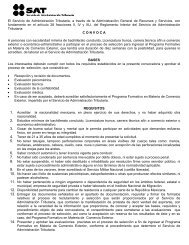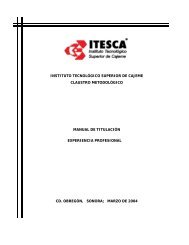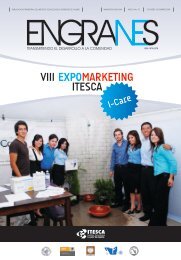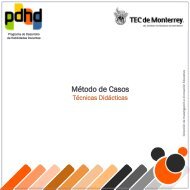Número 9 - Instituto Tecnológico Superior de Cajeme
Número 9 - Instituto Tecnológico Superior de Cajeme
Número 9 - Instituto Tecnológico Superior de Cajeme
Create successful ePaper yourself
Turn your PDF publications into a flip-book with our unique Google optimized e-Paper software.
ENTORNOACADÉMICO<br />
Conclusiones<br />
1.-Se ha utilizado el remallado adaptativo en esta<br />
simulación con resultados a<strong>de</strong>cuados en la zona<br />
primaria <strong>de</strong> corte.<br />
2.- Con el uso <strong>de</strong> este software no es posible utilizar el<br />
remallado adaptativo en áreas específicas como son<br />
aquellas en las que ocurren altas <strong>de</strong>formaciones plásticas;<br />
solo se logró en la zona primaria <strong>de</strong> corte, en la<br />
zona terciaria don<strong>de</strong> se requiere analizar el acabado<br />
superficial y los esfuerzos residuales, no se aprecian<br />
en forma a<strong>de</strong>cuada, a pesar <strong>de</strong> que fue utilizado un<br />
mallado fino.<br />
3.-Para obtener resultados más aproximados a la<br />
realidad en las diferentes zonas, se requiere implementar<br />
una técnica más efectiva para analizar el<br />
fenómeno <strong>de</strong> corte, se propone usar la técnica <strong>de</strong><br />
partículas suaves hidrodinámicas (SPH) que incluye la<br />
aproximación ALE.<br />
Referencias<br />
[1]A. Raczy, W.J.Altenhof, and A.T.Alpas: “An<br />
Eulerian Finite element mo<strong>de</strong>ling of metal cutting<br />
process.<br />
[2] COMMAS COURSE notes by Prof. Manfred<br />
Bischoff, Prof. Cristian Miehe, Prof. Wolfgang Ehlers:<br />
“Computational mechanics of structures, micro<br />
mechanics of materials and homogenization methods,<br />
continuum mechanics, October 2006-October 2007.<br />
[3] Halil Bil: “Simulation of orthogonal metal cutting<br />
by finite element analysis, August 2003.<br />
[4] Halil Bil, S. Engin Kilic, A.Erman Tekkaya: A<br />
comparison of orthogonal cutting data from experiments<br />
with three different finite elements mo<strong>de</strong>ls,<br />
2004, <strong>de</strong>partment of mechanical engineering, Middle<br />
east Technical University, Ankara Turkey, International<br />
Journal of machine tools manufacture 44, 2004<br />
933-944.<br />
[5] J. Limido, M. Sala n, C.Espinoza, J.L. Lacome: “A<br />
new approach of high speed cutting mo<strong>de</strong>ling: “The<br />
SPH method, Ensica, LSTC, 2007.<br />
[6] Livermore software technology corporation<br />
(LSTC): “LS-DYNA Keyword user’s manual, volume<br />
1, version 971, may 2007.<br />
[7] M.Barge, H. Hamdi, J. Rech, J.M. Bergheau:<br />
“Numerical mo<strong>de</strong>ling of orthogonal cutting: Influence<br />
of numerical parameters”, Journal of materials<br />
processing Technology; 164-165 (2005) 1148-1153.<br />
[8] M. Movahhedy, M.S. Gadala y Altintas: “Simulation<br />
of the ortogonal metal cutting process using an<br />
arbitrary Lagrangian-Eulerian finite-element method,<br />
Journal of materials processing Technology method,<br />
Journal of materials processing Technology 103, 2000<br />
267-275, March 1999.<br />
[9] Prakash M. Dixit, Uday S. Dixit; 2008; “Mo<strong>de</strong>ling<br />
of metal forming and Machining Processes by FE and<br />
Soft Computing Methods”; Springer.<br />
[10] Rudolf B ttiecher: “Advances in adaptive thermalmechanical<br />
metal forming simulations in LS-DYNA”,<br />
TMB GMBH, 2006.<br />
[11] S.P.F.C. Jaspers, J.H. Datzenburg: “Material<br />
behavior in metal cutting; Strains, strain rates and<br />
temperatures in chip formation”, 21st November 2001.<br />
[12] Stefan Hoppe: “Phd Thesis on experimental and<br />
numerical analysis of chip formation in metal cutting”,<br />
Aechen, January 2004.<br />
[13]T.D. Marusich M. Ortiz: “Mo<strong>de</strong>lling and simulation<br />
of high-speed machining, Division of Engineering,<br />
Brown University, provi<strong>de</strong>nce RI 02922, USA.<br />
[14] Troy D. Marusich , Jeffrey D. Thiele and Cristopher<br />
J.Brand: “Simulation and analysis of chip breakage<br />
in turning process”, 2001.<br />
[15] Tugrul zel and Eron Zerel: Finite element mo<strong>de</strong>ling<br />
the influence of edge ruondness on the stress and<br />
temperatura fields induced by high-speed machining,<br />
Springer-Verlog London limet<strong>de</strong>d, 2006.<br />
[16] Tugrul zel and Yi Git Karpet: “I<strong>de</strong>ntification of<br />
constitutive material mo<strong>de</strong>l parameters for high-strain<br />
rate metal cutting conditions unsing evolutionary<br />
computational algorithms material and manufacturing<br />
process”, 22:659667, 2007.<br />
[17] Tugrul zel and Eron Zerel: Finite element mo<strong>de</strong>ling<br />
simulation of machining of AISI 1045 steel with a<br />
round edge cutting tool, Departament of industrial<br />
and systems engineering, Rutgers, the state university<br />
of New Jersey, Piscatway, new Jersey 08854 USA.<br />
[18] W.J.Kang, S.S. Cho and H.Huh: “Modified<br />
Johnson-Cook mo<strong>de</strong>l for Vehicle body crashworthiness<br />
simulation, Departament of mechanical<br />
Engineering, Korea Advanced Institute of science and<br />
technology, 373-1 Kusong dong, Yusonggu, Taejon<br />
305-701, Korea.<br />
Nota Autobiográfica<br />
M.I. Baldomero Lucero Velázquez, Maestro en<br />
Ingeniería Mecánica UNAM, Profesor Investigador <strong>de</strong><br />
carrera titular “B” <strong>Instituto</strong> <strong>Tecnológico</strong> <strong>Superior</strong> <strong>de</strong><br />
<strong>Cajeme</strong>, Subdirección <strong>de</strong> investigación y posgrado,<br />
Doctorante en Ingeniería Mecánica por la Universidad<br />
<strong>de</strong> Guanajuato Campus Irapuato-Salamanca, Cd.<br />
Obregón Sonora México. blv72@hotmail.com;<br />
blv@itesca.edu.mx.<br />
Dr. Eduardo Aguilera Gómez, Profesor Investigador<br />
tiempo completo SNI 1, Universidad <strong>de</strong> Guanajuato<br />
campus Irapuato-Salamanca eag@salamanca.ugto.mx<br />
Dr. Elías Le<strong>de</strong>sma Orozco, Profesor Investigador<br />
tiempo completo SNI1, Universidad <strong>de</strong> Guanajuato<br />
campus<br />
Irapuato-Salamanca<br />
elias@salamanca.ugto.mx<br />
M.I. Eusebio Jiménez López, Profesor investigador<br />
Universidad Tecnológica <strong>de</strong>l Sur <strong>de</strong> Sonora, Cd.<br />
Obregón, Sonora, México ejimenezl@msn.com<br />
M.I. Juan José Delfín Vásquez, Profesor Investigador<br />
<strong>Instituto</strong> <strong>Tecnológico</strong> <strong>Superior</strong> <strong>de</strong> <strong>Cajeme</strong>, Cd.<br />
Obregón, Sonora, México j<strong>de</strong>lfin@itesca.edu.mx<br />
M.I. Adolfo Elías Soto González, Profesor Investigador<br />
<strong>de</strong> carrera titular “B” <strong>Instituto</strong> <strong>Tecnológico</strong> <strong>Superior</strong><br />
<strong>de</strong> <strong>Cajeme</strong> , Cd. Obregón, Sonora, México<br />
asoto@itesca.edu.mx


